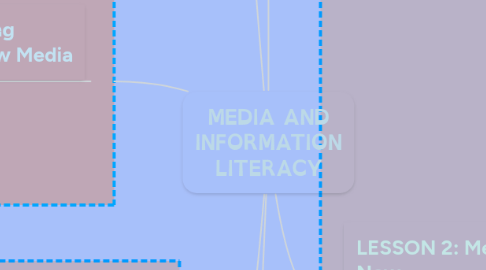
1. LESSON 4: Understanding Media: Aesthetics of Film and TV
1.1. 4.1 The Film Form
1.1.1. 4.1.1 Models of Film Production
1.1.2. 4.1.2 FilmFormats
1.1.2.1. 4.1.2.1 Narrative
1.1.2.2. 4.1.2.2 Documentary
1.1.2.3. 4.1.2.3 Animation
1.1.2.4. 4.1.2.4 Experimental
1.1.3. 4.1.3 Film Image Composition
1.1.4. 4.1.4 Motion Framing Concepts
1.2. 4.2 The TV Broadcast
1.2.1. 4.2.1 Kinds of TV Shows
1.2.1.1. 4.2.1.1 Informative Programming
1.2.1.2. 4.2.1.2 Entertainment Programming
1.2.2. 4.2.2 TV Shows Anatomy and Advertising
1.3. 4.3 Crafting Media Messages
1.3.1. 4.3.1 Creating Meaning in Audio Production
1.3.2. 4.3.2 Creating Meaning in Image Production
1.3.3. 4.3.3 Creating Meaning in Audiovisual Production
2. LESSON 5: Understanding Media: Aesthetics of New Media
2.1. 5.1 Deconstructing New Media
2.1.1. 5.1.1 New Media Technology: Convergence and Characteristics
2.1.2. 5.1.2 New Media as Multimedia
2.1.3. 5.1.3 New Media Transition: from Synergy to transmedia
2.2. 5.2 Intersecting Traditional Media and New Media
2.2.1. 5.2.1 Journalism + Internet = blogging
2.2.2. 5.2.2 Broadcasting + Internet = Podcast
2.2.3. 5.2.3 Film + Internet = YouTube
2.3. 5.3 Transitioning Media, Transitioning Users
3. LESSON 6: Understanding Media: Aesthetics of Social Networking
3.1. 6.1 Deeper Understanding of Social Media
3.1.1. 6.1.1 What is Social Networking
3.1.2. 6.1.2 Kinds of Social Media and Its Varying Uses
3.1.2.1. 6.1.1 Print-Based
3.1.2.2. 6.1.2 Audio-Based
3.1.2.3. 6.1.3 Photo-Based
3.1.2.4. 6.1.4 Video-Based
3.1.2.5. 6.1.5 Social Networking Sites
3.2. 6.2 Relevance of Social Media in Today's Society
3.2.1. 6.2.1 Personal Communication
3.2.2. 6.2.2 Business and Customer Care Tool
3.2.3. 6.2.3 Social Services and Governance
3.2.4. 6.2.4 Educational Tools
3.2.5. 6.2.5 Advocacy Campaigns for Social Change
3.2.6. 6.2.6 Traditional Media Coverage and Social Media Enhancement
3.2.7. 6.2.7 Entertainment Portals
4. LESSON 1: What is Media?
4.1. 1.1 Defining "Media"
4.1.1. 1.1.1 The Communication Process
4.1.2. 1.1.2 The Feedback Mechanism
4.1.3. 1.1.3 Media as an Information Industry
4.1.4. 1.1.4 Media as a Culture of Entertainment
4.2. 1.2 Kinds of Media
4.2.1. 1.2.1 Traditional Media
4.2.2. 1.2.2 New Media
4.2.3. 1.2.3 Social Media
4.2.4. 1.2.4 Mobile Communications Technology
4.2.5. 1.2.5 Related and Emerging Technologies
5. LESSON 2: Media Then and Now
5.1. 2.1 Brief History of Media
5.1.1. 2.1.1 Pre-industrial Age
5.1.2. 2.1.2 Industrial Age
5.1.3. 2.1.3 Electronic Age
5.1.4. 2.1.4 Digital Age
5.2. 2.2 Brief History of Philippine Media
5.2.1. 2.2.1 Pre-colonial Traces
5.2.2. 2.2.2 The Print Industry and Filipino Freedom
5.2.3. 2.2.3 The European Film Import
5.2.4. 2.2.4 The Broadcast Indusry
5.2.5. 2.2.5 Local Online Media
5.3. 2.3 The State of Media Today
5.3.1. 2.3.1 The Local landscape
5.3.2. 2.3.2 From Globalization to Glocalization
5.4. 2.4 Media Ownership
5.4.1. 2.4.1 Mainstream Media
5.4.2. 2.4.2 Alternative and Independent Media
5.4.3. 2.4.3 Community Media
5.4.4. 2.4.4 State-owned Media
6. LESSON 3: Understanding Media: Aesthetic of the Image, Text, and Audio
6.1. 3.1 Framing and Reading
6.1.1. 3.1.1 Newspaper and Journalism
6.1.2. 3.1.2 Books, Comics, Magazines, and the Publishing Industry
6.1.3. 3.1.3 Photography and Timeless Image Concepts
6.2. 3.2 Framing Listening
6.2.1. 3.2.1 Radio and Evoking Imagination
